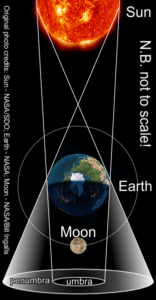
A lunar eclipse occurs when the shadow of the Earth passes across the surface of the Moon. In other words, at some point on the Moon’s surface, the Earth’s disc would appear to pass in front of the Sun.
Unlike solar eclipses, when a lunar eclipse occurs it is visible from anywhere on Earth where the Moon is visible. This means that, although there are actually fewer lunar eclipses than solar eclipses, they seem to occur more often because they can be observed from a much larger area on the Earth’s surface when they do occur.
Total and Partial Lunar Eclipses
A total lunar eclipse takes place when the Moon passes through the umbra of the Earth’s shadow, such that no part of the Sun’s disc would be visible to an observer anywhere on the Moon’s surface.
A partial lunar eclipse occurs when just a portion of the Moon’s surface is within the umbra or penumbra of the Earth’s shadow. A total lunar eclipse also has a partial phase as the Moon enters into the Earth’s shadow, passing first through the shadow’s penumbra. The penumbra is the region of the Earth’s shadow where, to an observer on the Moon’s surface, some portion of the Sun’s disc would still be visible behind the Earth.
Even the part of the Moon within the umbra of the Earth’s shadow will not in total darkness, due to light refracted through the Earth’s atmosphere. As blue light is scatted more readily by the atmosphere, most of the light reaching the Moon’s surface will be in the red part of the spectrum. For this reason, a total lunar eclipse is often known as a ‘blood moon’.
List of Recent and Upcoming Total Lunar Eclipses
31 January 2018 – totality starts 12:52 UTC, totality ends 14:08 UTC
27 July 2018 – totality starts 19:30 UTC, totality ends 21:14 UTC
21 January 2019 – totality starts 4:41 UTC, totality ends 5:43 UTC
26 May 2021 – totality starts 11:10 UTC, totality ends 11:28 UTC
16 May 2022 – totality starts 3:28 UTC, totality ends 4:54 UTC
08 November 2022 – totality starts 10:16 UTC, totality ends 11:42 UTC
14 March 2025 – totality starts 6:26 UTC, totality ends 7:32 UTC
07 September 2025 – totality starts 17:31 UTC, totality ends 18:53 UTC
03 March 2026 – totality starts 11:03 UTC, totality ends 12:03 UTC
31 December 2028 – totality starts 16:16 UTC, totality ends 17:28 UTC
26 June 2029 – totality starts 2:31 UTC, totality ends 4:13 UTC
20 December 2029 – totality starts 22:15 UTC, totality ends 23:09 UTC